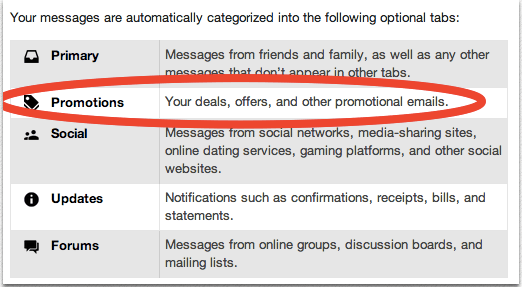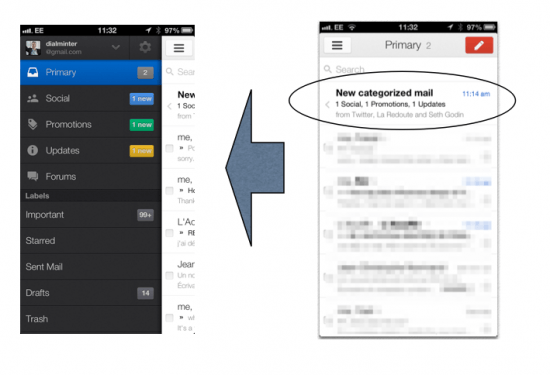As email marketing remains one of the cheapest and most effective digital marketing tools around, you would think that a marketing team might be more inclined to invest in and hire an email marketing specialist than a social media specialist. It remains my conviction that email marketers should excel at social as well, as I shall elaborate below.
Gmail Inbox
Gmail changed its inbox rather dramatically in late May this year (read here for the Google Blog post explaining the change). For those of you who don’t have Gmail, the inbox now looks like this:
Unless the user disables the new design, Gmail will automatically organize your emails according to the following (ideal) criteria in 5 different tabs:
To enable the Gmail tabbed inbox, click the gears icon from Gmail on the desktop and select “Configure inbox.” This will provide the option to set up inbox tabs. For this functionality to be visible in iOS mobile / tablet, you will first need to configure on the desktop. As you can see in the image below, the tabs are hidden in the left bar. The Apple iOS resident email obviously doesn’t cater to these gmail-specific filters so it’s a good reminder for gmail users of those non-primary mails. In a very recent move, Gmail now provides in its mobile/tablet interface a push mail into the primary inbox, alerting the user of new mail in the other tabs (a clear sign that mobile users are not ‘converting’ enough!). The same mail will not appear in the desktop inbox.
Email marketers’ hell?
In this system, all “personal” mails will appear in the primary tab. What matters for brands is that promotional emails and newsletters will generally land in the Promotions tab (third); on occasion a newsletter will land in the Updates tab (fourth). Users can fine tune which tabs they want and can also re-tag certain mail to land in other tabs. It is not a perfect system, but it is designed to make the user’s email experience better. For email marketers, your campaigns will no longer land directly in front of the user’s eyeballs. Companies like Gilt and Gap have tried to persuade their customers to force their emails back into the primary tab*. But for others, they are now “relegated” to this other tab. Is this a bad thing? The numbers are still sketchy and Google has released no data, but a number of services have reported small shifts in open rates. In particular, I liked the deep dive analysis from MailChimp which showed a definite, if small decline in open rates. Meanwhile, as Rebecca Greenfield wrote in the Atlantic Wire, maybe soon, Google will start charging for the privilege of landing in the right inbox tab?
Or good news?
My personal opinion is that, since it is making the primary inbox cleaner, it’s an improvement in the user experience and thus will help perpetuate the email channel. With this new organization, the chances are that some users may become less upset at the corporate pollution and will, possibly, be less inclined to delete with a vengeance the unwanted “spam”. Moreover, for brands, the further good news is that this type of reorganization will mean that the consumer’s receipt and opening of a non-primary mail becomes very much more deliberate. With the primary inbox kept clear, when the user decides to explore the other tabs, there is a greater openness to click on the other incoming messages. There is, of course, the ability to delete all incoming promotional mails with greater ease, much like when you go to clean out the spam folder. These new tabs represent another benefit versus the folders on the side in that they are more visible. Whereas it is possible to manually set up filters that have certain mail avert the inbox, the challenge then became whether or not the user would remember to go to the folders in the left bar.
Social email marketing
Whether or not email open rates decline from this new tab formation in Gmail, the bigger question is whether branded or corporate emails can improve their user friendliness or user usefulness. The email is a fabulous invention. However, for many people, it is also the bane of their existence. Brands whose newsletters can become a value-added presence in the inbox will surely win out over time. No one wants spam or one more unnecessary mail. One solution I see out there to corroborate the Gmail Inbox Tabs (where social is the second tab) is the filtering of email via the social network. What if a brand’s newsletter could only get through the filter if you had “liked” their page and/or a friend of a friend had liked their page? {Click to Tweet?} It’s what I call social email marketing or, less prosaically: socially connected email marketing. Today’s Gmail Tab and filter system is set up automatically by Gmail and they seem to have done a very good job. This is where I see a good concordance between email marketing and social media marketing skills. Moreover, we should be seeing the development of more social emails, whereby the social component is seeamlessly embedded in emails.
From a brand’s point of view, ask not how to get around the system. Ask why a user would really want to open your mail and be thankful for the content in it. {Please click to Tweet!}
———–
*I have noticed two possible workarounds for brands who want to “play” the system: if the “sent from” email is different each time, there is a tendency for the email to creep into the primary and, beacuse it’s a different email, it will not follow orders to be delivered into another tab. Secondly, unsurprisingly, it will land in the primary inbox if the email comes from a person in your contacts database.














Trackbacks/Pingbacks